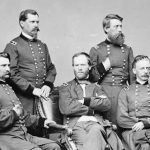 Music
Music  Music
Music  History
History 10 Less Than Jolly Events That Occurred on December 25
 Weird Stuff
Weird Stuff 10 Funny Ways That Researchers Overthink Christmas
 Politics
Politics 10 Political Scandals That Sent Crowds Into the Streets
 Weird Stuff
Weird Stuff Ten Bizarre Facts About The Doge Meme
 Our World
Our World 10 Ways Your Christmas Tree Is More Lit Than You Think
 Movies and TV
Movies and TV The 10 Coolest Stars to Set Sail on The Love Boat
 History
History 10 Things You Didn’t Know About the American National Anthem
 Technology
Technology Top 10 Everyday Tech Buzzwords That Hide a Darker Past
 Humans
Humans 10 Everyday Human Behaviors That Are Actually Survival Instincts
 Music
Music 10 Surprising Origin Stories of Your Favorite Holiday Songs
 History
History 10 Less Than Jolly Events That Occurred on December 25
 Weird Stuff
Weird Stuff 10 Funny Ways That Researchers Overthink Christmas
Who's Behind Listverse?

Jamie Frater
Head Editor
Jamie founded Listverse due to an insatiable desire to share fascinating, obscure, and bizarre facts. He has been a guest speaker on numerous national radio and television stations and is a five time published author.
More About Us Politics
Politics 10 Political Scandals That Sent Crowds Into the Streets
 Weird Stuff
Weird Stuff Ten Bizarre Facts About The Doge Meme
 Our World
Our World 10 Ways Your Christmas Tree Is More Lit Than You Think
 Movies and TV
Movies and TV The 10 Coolest Stars to Set Sail on The Love Boat
 History
History 10 Things You Didn’t Know About the American National Anthem
 Technology
Technology Top 10 Everyday Tech Buzzwords That Hide a Darker Past
 Humans
Humans 10 Everyday Human Behaviors That Are Actually Survival Instincts
The Ten Worst Generals in the History of Warfare
They say that the winners write the history books. That may be true, of course. But with every winner comes a loser, too. In many of those history books, the losers are featured very prominently. See, every war that gets fought has a side that comes out on top and a side that… doesn’t. So, even though we like to follow the military generals who were shrewd and cunning and successful, just as many losing generals have existed throughout the history of warfare, too.
Those losers don’t get as much of a focus in the minds of folks who look back at old wars, but they should. Forget all the great military generals of the past. Shed the intelligent tacticians and smart fighters from your minds. In this list, we’re going to focus on the awful generals, the ineffective leaders, and the wartime stiffs. From William Hull to Erich Ludendorff, to Gideon Pillow and many more—they’re all here. Let’s get weird!
Related: 10 Bizarre Battles That Took Place Where You’d Least Expect
10 John Pope
In the summer of 1862, Abraham Lincoln recognized the need to have more capable military generals and a much larger army on the eastern front of the Union’s fight in the Civil War. So he transferred Major General John Pope from where he’d been stationed in the west that summer to an eastern outpost. In doing so, General Pope came under the command of the newly created Army of Virginia. Its job was a simple one: cover northern Virginia, hold the line across that portion of the state, and keep the Confederacy at bay there while Major General George McClellan (who we’ll discuss in a second!) campaigned along the Virginia Peninsula. Simple, right?
Well, it should have been. Major General Pope had every opportunity to succeed at that task with a lot of men at his disposal. But right from the start, things took a turn for the worse (and the weird). It began on July 14, 1862, when Pope’s introductory address to his men contained tons of self-flagellation and boasting with little else. He bragged about where he’d been and what he’d done, but he showed no interest in how hard his new charges had been fighting before he got there. Nor did he seem to care that his opponents were strong at the time, too.
That was a problem because Pope’s men were led right into a stupid and extremely avoidable trap at the Second Battle of Manassas—also known as the Second Battle of Bul Run—not long after he took command. And then famed Confederate General Robert E. Lee completely decimated Pope’s army. Lincoln brought the guy in to do one thing—protect northern Virginia from the Confederate onslaught—and Pope failed at that almost immediately. And he bragged about himself the whole way down. Not exactly a wise tactician… or a humble one![1]
9 Douglas Haig
Many generals failed miserably in their commands during World War I. Technology at the time had changed so rapidly that most military leaders didn’t have a good grasp on how it would alter fighting in battle forever. Unfortunately for the men in his command, British commander Douglas Haig was one of those leaders. As the war began, Haig completely dismissed the dangers of machine gun fire on the battlefield. He thought he could push his men right through the firing fields—as though the relentless machine gun shots wouldn’t bring them all down.
On July 1, 1916, he ordered his men to go over the top and across the war front at the First Battle of Somme. Nearly 20,000 of them died immediately when they were mercilessly fired on by German machine gunners. General Haig may have lost twice as many men (in a single day, no less!!) as the notorious First Duke of Wellington had lost during the entire Peninsular War, but he refused to change tactics. He continued to assume that going over the top and running out into the fields would eventually win the war. And he continued to lose men. In total, the British lost roughly 420,000 men at the Somme.
The next notably bungled offensive on General Haig’s end came at a place called Passchendaele. There, from July 31, 1917, through early November of that year, he lost another 275,000 troops. That long and miserable slog became synonymous with pointless, endless, and needless slaughter. After the war, General Haig was viewed so badly by the British public for having sent so many men to quick and ineffective deaths that it was said the soldiers had been “lions led by donkeys.” That phrase came to be closely associated with General Haig specifically, as well as other British military commanders. Not exactly a great mark to leave on the world![2]
8 William Hull
William Hull is the only general officer in the history of the American military to be actually ordered before a firing squad for both dereliction of duty and cowardice on the battlefield. That’s not a wonderful way to begin his story, now, is it? Hull had been an outstanding soldier during the Revolutionary War. Then, he was appointed the governor of Michigan Territory in 1805. So, when the War of 1812 broke out, he was ready. Hull was commissioned as a brigadier general and ordered to keep Michigan safe from invaders rushing in from the north, in what was then known as Upper Canada. But by then, Hull was nearly 60 years old, timid, slow on the uptake, and scared of his foes. It wasn’t a good combination.
British General Isaac Brock was a remarkable tactician, and it didn’t take him long to get General Hull’s number as he invaded from the north. Even worse, Shawnee Chief Tecumseh and his men came along with General Brock. Tecumseh was possibly an even better tactician than Brock and was the head of the most powerful pan-Indian military force ever assembled in North America. In other words, General Hull was in for a doozy. While Hull dithered, they captured land. Then, Hull ordered his men to evacuate Fort Dearborn—and they were promptly slaughtered by a band of Potawatomi warriors who were waiting for them. The battles went on like that for a while, with Tecumseh’s incredibly agile raiding parties wreaking complete havoc on Hull’s slow-moving men.
On the night of August 15, 1812, Brock and Tecumseh set their sights on Fort Detroit. Brock began firing cannons from the Canadian side of the river while Tecumseh sent out his men all around the fort in an endless procession. Terrified, Hull surrendered the fort and all 2,000 of its men without a single shot being fired. He assumed he was outnumbered. But he wasn’t—and it wasn’t even close. Regardless, he was taken prisoner by the British, and they gained control of the fort and all of its assets. They then took control of nearly the entire Michigan Territory, as Hull’s quick surrender had left a complete vacuum of power on the American side.
In the end, Hull was held prisoner by the British for much of the rest of the war. When he was finally returned to the United States, he was promptly court-martialed for his cowardice and his completely ineffective work as a general. He ended up being found guilty of 11 counts and was ordered before the firing squad. But just before it was time for him to die, President James Madison intervened and spared him from execution. Hapless, Hull was—and he survived only by the grace of an apologetic president.[3]
7 George McClellan
George McClellan had a great resume: second in his class at West Point, experience as an observer in the Crimean War, a keen understanding of logistics for an industrialized military, and years of work in private life as the chief of engineering for the Illinois Central Railroad. So, why was he such a terrible Civil War general? Well, for one, he was supremely talented at overestimating the size of his opponent’s forces. And because of that, for months and months during the contentious Civil War, he absolutely refused to fight any Confederate foes. Paralysis by analysis, perhaps. And a problematic quality when you are supposed to lead literally the ENTIRE Union Army into battle!
Finally, Abraham Lincoln convinced McClellan to take on the Peninsular Campaign through the late spring and early summer of 1862. Lincoln wanted him to march directly to the Confederate capital of Richmond. Instead, McClellan chose to do an amphibious landing of more than 100,000 troops at Fort Monroe. He was immediately checked by a Confederate force under John Bankhead Magruder. Even though Magruder’s men were outnumbered 10-to-1 by McClellan’s massive force, the Union general again became paralyzed by analysis and refused to simply overrun the Southerners.
Eventually, McClellan slowly made his way toward Richmond. But then Robert E. Lee showed up. As bad of a general as McClellan may have been, Lee was a great one, and the Confederate leader quickly recognized he was dealing with a wimp on the other side. So, even though the Confederates were on their heels, Lee went on the warpath. He burst through McClellan’s lines and devastatingly defeated the Union. Frustrated, Lincoln eventually relieved McClellan of his duties. He was reinstated for a time later, though—and badly stumbled once again at the Battle of Antietam. Oh, and as if that’s not enough, McClellan turned around and ran for President in 1864 but lost in a rout. Such was his way![4]
6 Erich Ludendorff
It all started off so well for Erich Ludendorff. In the opening month of World War I, he led a massive German victory against the Russians at Tannenberg. But Ludendorff couldn’t leave well enough alone when, in the early years of World War I, it seemed like Germany would settle in and fight their continental foes—and maybe even win. See, Ludendorff wanted more. Specifically, he wanted submarine warfare. More than any other German general during the 1910s, he was the one pushing hard for unrestricted submarine attacks against Allied shipping—and even neutral countries like the United States.
We all know what came next: the sinking of the Lusitania. Under Ludendorff’s very pronounced push, German submarines began more frequently attacking innocent ships, including those carrying civilians. After they sank the Lusitania, the United States joined World War I. That suddenly became a massive problem for Ludendorff, considering that his military now had to fight on two massive fronts, much bigger and more challenging than before the U.S. arrived on the scene. In the end, the Americans could produce soldiers and weapons much more quickly than the beleaguered German army. Despite Ludendorff’s calls to keep fighting, the Treaty of Versailles nixed things for his nation.
But Ludendorff’s awful military strategies weren’t finished there. After the Treaty of Versailles practically cut the German economy and recovery down to its knees, Ludendorff started going around with what has since been called the “stabbed in the back” theory. He told anyone who would listen that his armies had actually been undefeated on the battlefield (he was a good military strategist, but that wasn’t true). Furthermore, he claimed that the newly formed Weimar Republic was a conspiracy to hurt regular Germans. He then became a key participant in the Beer Hall Putsch and the subsequent rise of Adolf Hitler. He even wrote a book about why perpetual warfare is a good thing and why humans are meant to fight one another all the time!
In the end, Ludendorff’s flagrant actions away from the battlefield after World War I led directly to the storm clouds that brought World War II back to the continent so soon after that. It was made even worse by the fact that Ludendorff himself died in 1937. So, he very publicly propagated a whole host of awful ideas for years on end and then dipped out before he had to cash the check with the rest of the continent. Real classy, dude.[5]
5 Pierre de Villeneuve
Naval Admiral Pierre de Villeneuve got his first taste of leading a high-end battle in 1798 when his French ship and many others went up against the British Navy at the Battle of the Nile. Except, to be clear, de Villeneuve didn’t actually “go up” against anybody in that battle. While the British completely routed the French and captured all but two of France’s ships, de Villeneuve retreated cowardly to Malta and hung out for a while. Eventually, the British took Malta, too, and he was captured. But his story of ineptitude was only just beginning.
The British quickly realized de Villeneuve was hapless, so they released him after a while. Then, as Napoleon Bonaparte’s actually capable French admirals kept dying in battle or falling into disfavor with the short leader, de Villeneuve recognized a power vacuum. He swept back in, and in 1804, he was placed in charge of the French naval fleet at Toulon. His job? To draw Horatio Nelson’s British fleet out to the Caribbean for a supposed battle royale. Then, de Villeneuve was supposed to secretly abscond back to the English Channel and help prepare for a land invasion of England.
He didn’t obey his orders, though. Instead of sailing for the English Channel, he went straight to Cadiz, Spain. That mishap and the wait that the rest of the French forces had to endure while calling on de Villeneuve to show up at their actual aforementioned meeting spot allowed Nelson’s fleet to return. The British responded by blockading the port of Cadiz and trapping de Villeneuve inside. Napoleon was rightfully incensed, and he informed de Villeneuve that the useless admiral was to be relieved of his duties.
In a fit of anger at getting fired and stuck with nowhere to go in the port of Cadiz, de Villeneuve did what only a foolish man might do: He lashed out at Nelson’s powerful fleet. The subsequent Battle of Trafalgar was such a complete and total victory for the British that it established their naval dominance worldwide for well over a century after that. Poor ol’ de Villeneuve lost twenty ships in the fighting; Nelson lost just one. Now, Nelson himself was killed at Trafalgar, and de Villeneuve survived. But it was of little solace for the man who would have to face Napoleon’s wrath. Rather than go through that, the French admiral committed suicide to end it all quickly (and cowardly).[6]
4 Gideon Pillow
Great name… terrible general. Gideon Pillow first displayed his ineptitude during the Mexican-American War when U.S. President James K. Polk made him the major general after the pair had been friendly for years. Pillow immediately became a laughingstock down there when he had his men entrench themselves on the wrong side of the fortifications at Camargo. Yes, you read that right. Then, he messed up a flanking maneuver at the Battle of Cerro Gordo, too. As if that weren’t enough, later in the war, he submitted completely phony accounts of his supposed achievements in the Battles of Contreras and Churubusco, too.
The American commander Winfield Scott came to detest Pillow for all his mistakes and those lies. But it was about to get so much worse. Scott once wrote that Pillow was “the only person I have ever known who was wholly indifferent in the choice between truth and falsehood.” At the end of the conflict with Mexico, Pillow even moved to steal a cannon (yes, a cannon) and take it home with him. He was caught and court-martialed for that devious act. But President Polk personally intervened and kept Pillow out of trouble. So, at the end of the Mexican-American War, he returned home to Tennessee.
Once there, as talk of the Civil War bubbled up, Pillow organized a state militia. He was eventually appointed as a brigadier general for the Confederacy. After actually winning a battle at Belmont, he was tasked with leading Confederate troops to defend Fort Donelson along the Mississippi River. Ulysses S. Grant was on the warpath, though. Pillow went on the offensive and actually had Grant on his heels at first. But then, Pillow made a colossal error: He retreated his men back to the fort rather than charge through the Union’s weekend lines.
The Union Army quickly recovered and returned for a second fight against Pillow’s men. By then, the northerners had much more manpower backing them, and they proved too much for Pillow’s men to handle. But rather than accept defeat like an esteemed general, Pillow didn’t stick around to see the fort surrendered. Instead, he ran off in the night, escaping with his life—but forever earning the derision of his men for the cowardly act.[7]
3 Francisco Solano López
It isn’t that hard to find Paraguay on a map of South America (er, uh, we hope.) Look it up, then take note of the vast expanses of land to the north and south that belong to other countries—like Argentina, Brazil, Uruguay, and Bolivia. Lots of nations there, right? Well, a mostly useless military general named Francisco Solano López singlehandedly and inadvertently led Paraguay into a war with nearly every single one of those countries in the middle of the 19th century. Not great, Francisco!
The unfortunate fellow was the son of a man named Carlos Antonio López. He’d been a dictator who had significantly modernized Paraguay in the middle of the 19th century. By the end of his reign, the elder López left his son with a relatively powerful military, at least by regional standards. But the old man warned his son of one critical thing: not to use the military to resolve diplomatic conflicts. Something tells us you can probably guess what happened ne…
By December 1864, Francisco and his beloved nation were at war with Brazil. That month, Argentina refused to allow a Paraguayan military outfit to pass through its territory. Angry about that show of disrespect, López declared war on Argentina as well. In turn, frustrated by Francisco’s poor interpersonal dealings, this prompted Argentina, Brazil, and the Brazilian-aligned government in Uruguay to form an alliance. That alliance then officially declared war on Paraguay on May 1, 1865.
The resulting War of the Triple Alliance, as it came to be known, devastated Paraguay. The fighting halved its pre-war population. Even worse, it led to the death of around 90 percent of its fighting-age men. Think about that for a second. True madness! Speaking of madness, in a likely fit of madness within himself, López wound the war down by demanding the execution of hundreds of loyal Paraguayans. That list even included some of his own family members. Eventually, he met his own demise in combat on March 1, 1870… but not before completely destroying his beloved homeland.[8]
2 Antonio López de Santa Anna
Mexican general Antonio López de Santa Anna likely wished everyone actually did remember the Alamo. After all, he won that battle. And glory came with it! During the 13-day siege, he somehow didn’t betray his loyalties. We say that because, well, staying loyal to himself (and not to his country) was a theme throughout the rest of Santa Anna’s life. His rise to power in Mexico was marked by constant shifts and betrayals of his allies. And to that end, he became one of the most controversial military leaders of the mid-19th century.
After the Texans defeated him at the Battle of San Jacinto, Santa Anna was captured. He promised to work for the U.S., but instead, he returned to Mexico. There, he quickly discovered that he had been ousted. He stuck around to fight for a career resurgence. In time, his reputation was partially restored after the Pastry War with France. Riding that high, he claimed dictatorial powers across Mexico once again.
In 1845, after being exiled once again, he reached out to American President James K. Polk. The occasion was a war that had broken out between Mexico and the United States. Unimpressed by any possible loyalty he might have to his own country, he offered to help the United States. The Americans accepted, and one of their ships brought him back to Mexico to support their cause. You’ll never guess what happened next: Santa ANna switched sides and took command of the Mexican troops. Thankfully for the Americans, this turncoat quickly wound up defeated by U.S. forces led by Winfield Scott. From there, he was exiled yet again.
A few years later, the French removed Benito Juárez and installed Maximilian as emperor of Mexico. Upon that move, a now-70-year-old Santa Anna reached out to the Americans once more. He wanted their help in toppling the emperor. And yet, at the very same time, he offered his services to Maximilian. Given his long history of double-dealing, both sides shot down the offers, and one of the most two-faced generals in military history was forced to slink off into the sunset[9]
1 Quintus Servilius Caepio
Many Roman generals were terrible, but one stood out: Proconsul Quintus Servilius Caepio. His actions at the Battle of Arausio were particularly foolish. For one, he refused to obey his superior, Consul Gnaeus Mallius Maximus. Then, Caepio wouldn’t even camp with the guy. But things got so much worse from there. On October 6, 105 BC, while Maximus was negotiating with the Cimbri tribe, Caepio attacked them. Very quickly, the Cimbri easily defeated Caepio’s forces. Then, enraged that Caepio would have gone after them, they chose to respond by attacking Maximus’s camp. In the melee, the Romans lost around 80,000 infantry and 40,000 auxiliaries and cavalry.
The loss was devastating for the Roman military at the time. As for Caepio himself, he somehow escaped the massacre unharmed. However, he lost his Roman citizenship, and he was quickly sent off into exile. Yet, despite this, he lived in luxury afterward. And here’s how that (may have) happened: During his ill-fated time in command, roughly 15,000 bars of gold went missing. None of that was ever found, and the suspicion by historians to this day is that the awful general stole it all for himself. As it turned out, then, Caepio may have been a bad general—but he was a skilled thief.[10]








